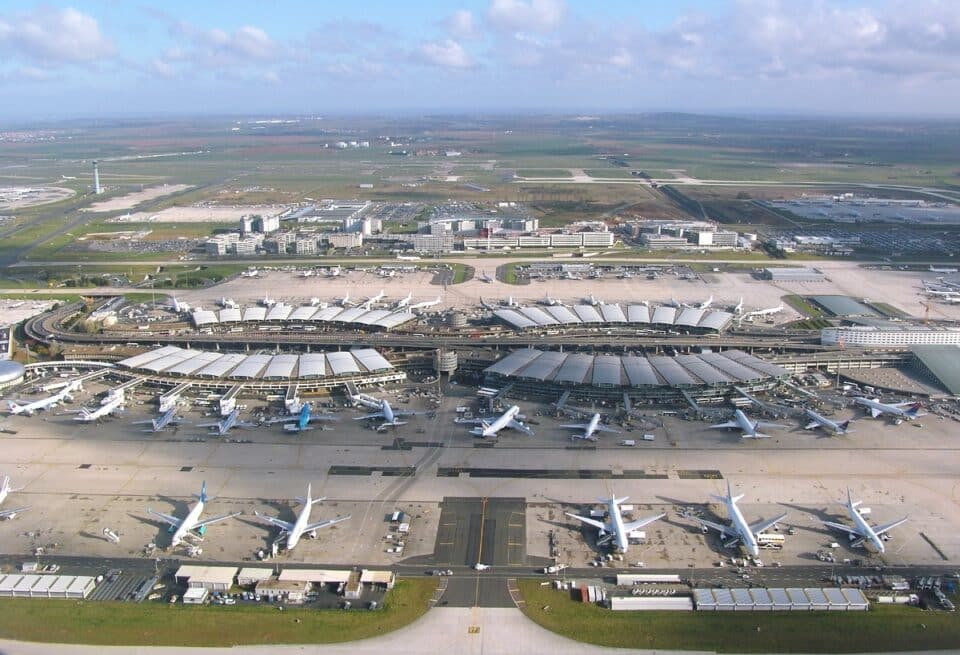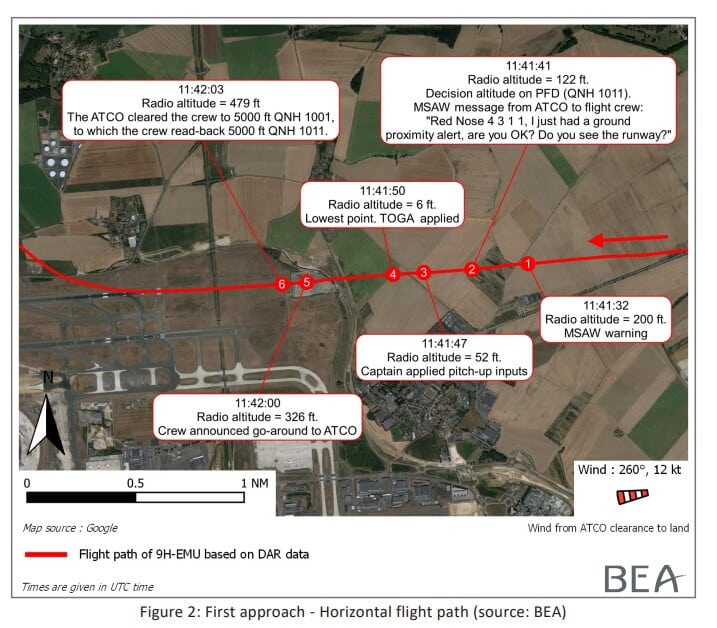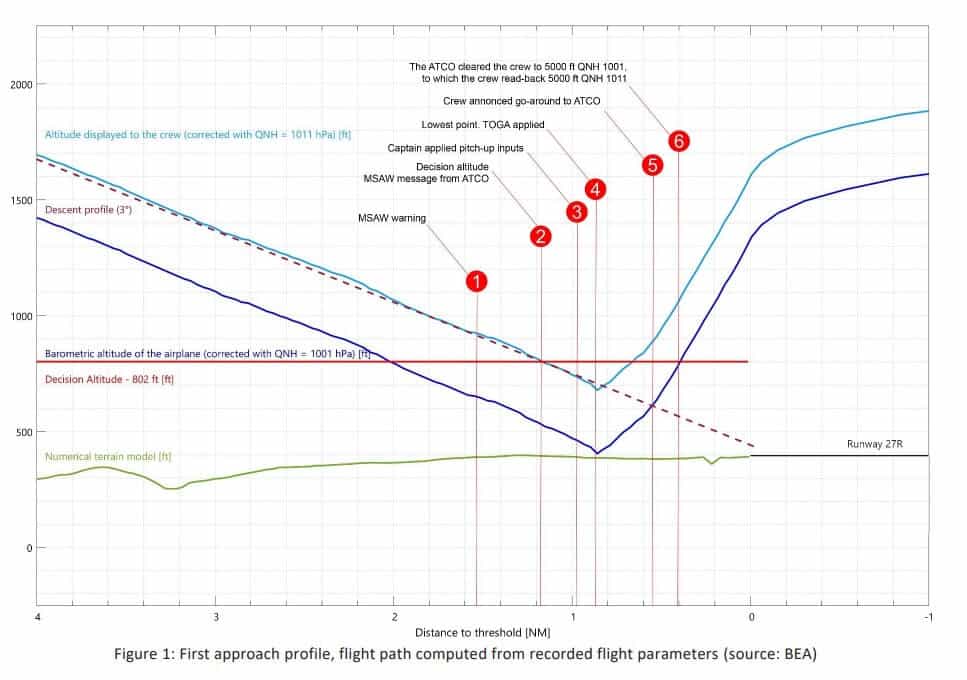Aviation
Airbus A320 comes within 6 ft of crashing while on approach to Paris

According to a report by French authorities, an aeroplane carrying 172 passengers came within 6 feet (1.8 metres) of crashing while making its approach to Paris Charles de Gaulle (CDG). On May 23, 2022, at at 11:40 UTC, the Airbus A320, with the registration 9H-EMU and operated by wet lease expert Air hub, was coming in to land at CDG on a trip from Stockholm Arlanda when the near-collision occurred because of an improper altimeter setting.
The approach was flown 280 feet lower than it should have been because the controller repeatedly gave the crew the wrong QNH setting, 1011 instead of 1001, and the crew failed to notice the error. The Minimum Safe Altitude Warning (MSAW) was triggered on both approaches during this serious incident, and the controllers failed to use the prescribed MSAW phraseology. The report noted that the crew was not provided the QNH or any instructions to verify their altitude.
For Air hub, the BEA recommends that crews are made aware of the importance of the correct QNH setting for such RNP approaches and implement a procedure to cross-check QNH information with another source.
First approach – Horizontal flight path
The flight, which was being flown on behalf of Norwegian Air Shuttle, was making an LNAV/VNAV minimum RNP approach to runway 27 at CDG. Because the aircraft will get its altitude information from the barometric altitude systems, this style of approach depends on pilots using the proper QNH setting.
According to the preliminary report from the BEA, air traffic controllers received a ground Minimum Safe Altitude Warning at 11:41:32, when the aircraft was at an indicated altitude of 617 ft on the correct QNH of 1001, or 200 feet above the ground according to the radio altimeter, at 1.53 nautical miles from the runway threshold. With a QNH setting of 1011, the crew would have seen an indicated altitude of 891 ft. CDG is 392 ft above sea level.
At 1.2 nautical miles from the runway, nine seconds later, the crew passed the decision altitude of 802 feet in accordance with the inaccurate 1011 QNH setting. The crew decided to turn around since they could not see the runway. However, the aircraft was 122 feet above the ground when the QNH was adjusted to the proper altitude of 1001, which was 537 feet.
The autopilot was removed and the captain pitched the aircraft up at 11:41:47, 15 seconds after ATC received the alert and during the controller’s call to the aircraft. The aircraft’s lowest point above the earth, measured by the radio altimeter at just 6 ft, was reached three seconds later and when it was still 0.8 miles from the runway.
Second approach
On the second approach for landing, the faulty QNH setting was not corrected, and the aircraft was again 280 ft lower than it should have been. Another MSAW was generated when the aircraft was 3.1 nm from the runway at an indicated altitude of 1,403 ft on QNH 1011 (but 1,131 ft QNH 1001, 842 ft per the radio altimeter).
When called by the controller, the crew said they did not understand why the message had been received but that they were visual with the runway. However, runway PAPI lights indicated to the crew that they were lower than they should be, so they corrected the approach and landed safely.
Courtesy : BEA

Aviation
Airbus Enhances A350 Cabin with 10-Abreast Seating

Airbus has announced a new partnership with Jiatai Aircraft Equipment, a Chinese aircraft seating manufacturer, to supply upgraded economy-class seats for the A350 widebody series.
This collaboration, unveiled at the 2024 Airshow China, focuses on developing a newly designed economy seat tailored for the A350‘s New Production Standard (NPS) cabin.
One of the key features of the NPS cabin is the ability to accommodate 17-inch wide economy seats, compared to the previous 16.5-inch wide seats that airlines were limited to in the A350’s earlier configurations.
British Airways Unveils Its Brand-New First Class Cabin for the Airbus A380
This change is made possible by the expanded space in the NPS cabin, which is 35 inches longer and 4 inches wider than the previous version. This extra space is achieved by slightly moving the cockpit wall forward and shifting the rear pressure bulkhead back by one frame.
The wider cabin allows airlines to add up to 30 extra economy seats without compromising comfort. For airlines opting for a 3-4-3 seating layout, the 17-inch wide seats are an excellent choice for a more comfortable passenger experience. However, some airlines, such as Iberia, may choose to retain a 9-abreast layout with wider seats for added comfort.
The NPS cabin also offers enhanced flexibility for airline operators. One major advantage is the ability to easily switch between a 9-abreast and 10-abreast seating configuration without requiring significant downtime for aircraft reconfiguration. Airlines can use the same seat rails, tracks, and IFE interfaces, making the transition smoother and quicker.
Etihad Airways Unveils 10 Exciting New Routes for 2025
In addition, the design of the floor attachments and air-conditioning systems has been optimized for 10-abreast seating, meaning airlines can upgrade their cabins without needing to make substantial modifications to the aircraft’s structure.
Though it’s still unclear when Jiatai’s economy-class seats will be officially added to the A350’s Buyer Furnished Equipment (BFE) catalogue, the collaboration marks a significant step toward enhancing the A350’s cabin offerings.
With this partnership, Airbus is providing more seating options for airlines, ensuring that they can meet diverse customer needs while improving overall operational efficiency.
-

 Aviation2 months ago
Aviation2 months agoMicrosoft Flight Simulator Raises $3 Million to Bring Back the An-225 Mriya
-

 Airlines2 months ago
Airlines2 months agoQatar Citizens Can Travel to the United States Without a Visa
-

 Aviation2 months ago
Aviation2 months agoQatar Airways bans these new Electronic Devices on plane
-

 Airlines2 months ago
Airlines2 months agoJapan Airlines Rolls Out Free Domestic Flights to International Passengers
-

 Travel2 months ago
Travel2 months agoQatar Airways Launches Four Additional Flights from Amsterdam
-

 Defence2 months ago
Defence2 months agoWhich Country Has the Largest Fleet of Fighter Aircraft?
-

 Airport2 months ago
Airport2 months agoWestern Sydney Airport Welcomes Its First Plane After 6 Years of construction
-

 Airlines4 days ago
Airlines4 days agoDAMAC Air: Dubai’s New Luxury Airline Offers Free Flights for Registration










